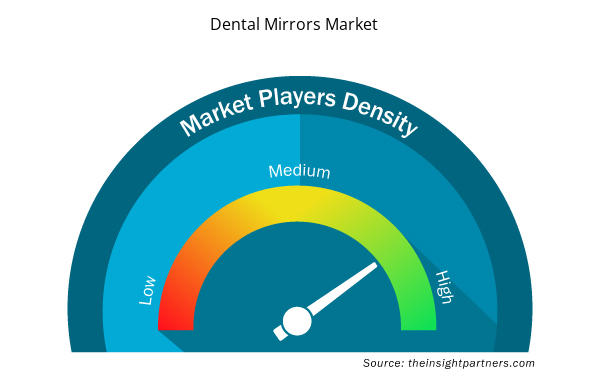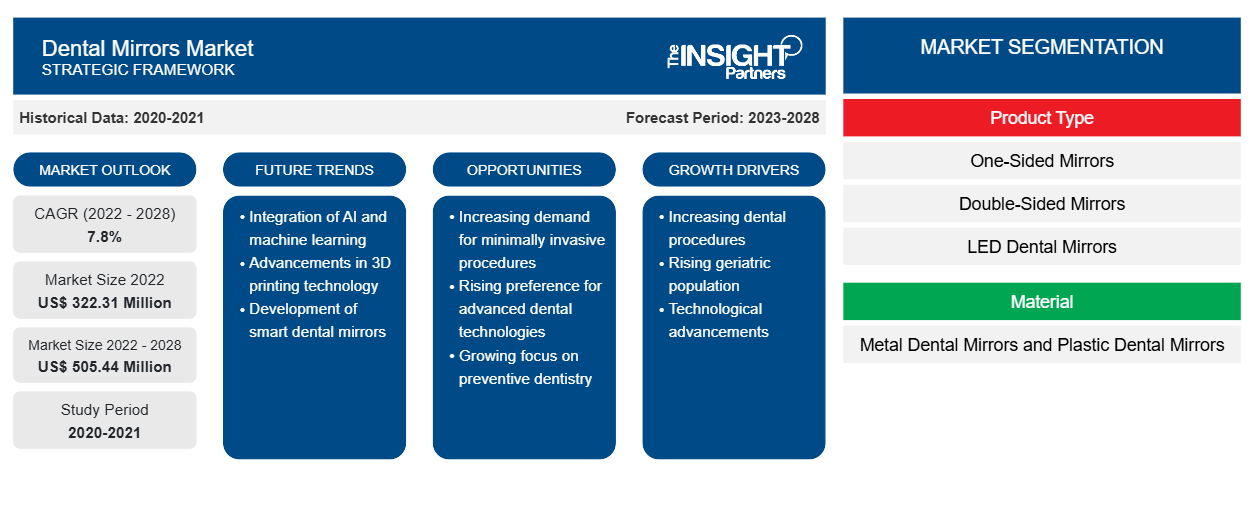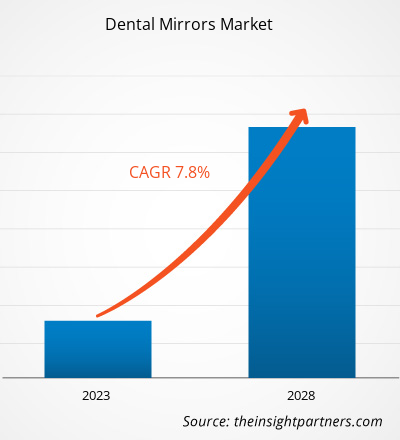牙科镜市场预计将从 2022 年的 3.2231 亿美元增长到 2028 年的 5.0544 亿美元;预计 2022 年至 2028 年的复合年增长率为 7.8%。
牙科镜又称牙医镜或口镜,是牙科常用的器械。镜子呈凹面形状,可让牙医放大患者口腔的反射并折射光线。双面牙科镜用于拉回脸颊或舌头,同时以间接视角观察另一侧。镜子使图像更大、更亮,方便牙医查看。双面镜的无缝隙结构可最大限度地提高患者的舒适度和清洁效率。
牙科镜市场根据产品类型、最终用户、材料和地理位置进行细分。按地理位置划分,市场大致分为北美、欧洲、亚太地区、中东和非洲以及南美和中美洲。本报告提供了对市场的见解和深入分析,重点关注市场趋势和动态等参数,以及全球领先市场参与者的竞争分析。
定制此报告以满足您的需求
您可以免费定制任何报告,包括本报告的部分内容、国家级分析、Excel 数据包,以及为初创企业和大学提供优惠和折扣
- 获取此报告的关键市场趋势。这个免费样品将包括数据分析,从市场趋势到估计和预测。
市场洞察
牙周病发病率上升推动牙科镜市场发展
口腔疾病(如口干、牙齿脱落、牙根管感染、牙齿创伤和蛀牙)在世界范围内的患病率正在上升。根据世界卫生组织 2019 年全球疾病负担研究,全球约有 35 亿人患有口腔疾病,尤其是龋齿。牙齿间隙、牙齿弯曲、牙齿拥挤和过度咬合等牙齿问题病例不断增加,增加了治疗此类问题的牙科手术需求,这反过来又推动了牙科镜市场的增长。例如,根据疾病控制和预防中心 (CDC) 的数据,在美国,30 岁以上年龄组中约有 47.2% 的成年人患有某种牙周病,并且随着年龄的增长而增加,2020 年约有 70.1% 的 65 岁以上成年人患有牙周病。
此外,中低收入国家(LMIC)人口口腔疾病患病率相对较高,且随着城市化进程和生活方式的改变而持续上升。根据埃塞俄比亚贡德尔大学的一项研究,2020年口腔疾病患病率为40.98%,尤其是在撒哈拉以南非洲地区,埃塞俄比亚为52.4%;苏丹和肯尼亚的患病率为50.3%,坦桑尼亚的患病率为40.2%。这种高患病率主要是由于接触口腔卫生产品或供水中的氟化物不足、高糖食物供应不足以及社区难以获得口腔卫生服务造成的。高糖食物和饮料以及烟草和酒精消费的增加,正在导致口腔健康状况和其他非传染性疾病。
产品类型洞察
根据产品类型,牙科镜市场分为单面镜、双面镜、LED 牙科镜和智能牙科镜。单面镜细分市场很可能在 2022 年占据最大的市场份额。然而,智能牙科镜细分市场预计将在预测期内实现最高的复合年增长率。单面镜可在不反转图像的情况下提供原始物体更明亮、更大的放大图像;因此,牙医可以看到内部的更大图像,使医生在观察牙齿内部和口腔时的工作更加轻松,因此牙医的增加正在推动该细分市场单面镜的增长。
材料洞察
根据材料,牙科镜市场分为金属牙科镜和塑料牙科镜。金属牙科镜部分可能会在 2022 年占据更大的市场份额。此外,预计同一部分将在 2022 年至 2028 年期间录得更快的复合年增长率。铝和银涂层都可以提供独特的优势,从而改善光学镜的功能。
此外,银涂层因其高反射率和持久耐用性而使初级镜、次级镜和三级镜受益,这增加了金属牙镜的采用,并且是金属牙镜领域增长的主要驱动因素。
最终用户洞察
根据最终用户,牙科镜市场细分为牙科诊所、医院和其他。到 2022 年底,牙科诊所细分市场可能会占据最大的市场份额。此外,预计同一细分市场将在 2022 年至 2028 年期间实现最高复合年增长率。牙科诊所细分市场的增长归因于全球牙科诊所数量的增加、牙科疾病患病率的激增以及人们可支配收入的增加等因素。牙科诊所提供各种牙科治疗设施,例如牙周病学、正畸学、牙科镜、牙齿美白、预防牙科等。
并购等无机发展是牙科镜市场公司广泛采用的策略。以下列出了一些近期的关键市场发展:
- 2019 年 9 月,Integra LifeSciences Holdings Corporation 收购了 Rebound Therapeutics,后者是一家一次性医疗设备的开发商,该设备允许使用光学和照明进行微创操作,用于神经外科手术的可视化、诊断和治疗。Rebound 的微创手术 (MIS) 技术具有集成光学和照明功能,能够与现有的手术室监视器连接。
- 2019 年 10 月,Hu-Friedy 推出了新款 HD 黑线镜。黑线镜以 HD 镜、黑线和 XTS 产品线的成功为基础,可在任何牙科手术过程中提供卓越的可视性。
牙科镜市场区域洞察
Insight Partners 的分析师已详尽解释了预测期内影响牙科镜市场的区域趋势和因素。本节还讨论了北美、欧洲、亚太地区、中东和非洲以及南美和中美洲的牙科镜市场细分和地理位置。

- 获取牙科镜市场的区域特定数据
牙科镜市场报告范围
| 报告属性 | 细节 |
|---|---|
| 2022 年市场规模 | 3.2231亿美元 |
| 2028 年市场规模 | 5.0544亿美元 |
| 全球复合年增长率(2022 - 2028) | 7.8% |
| 史料 | 2020-2021 |
| 预测期 | 2023-2028 |
| 涵盖的领域 | 按产品类型
|
| 覆盖地区和国家 | 北美
|
| 市场领导者和主要公司简介 |
|
牙科镜市场参与者密度:了解其对业务动态的影响
牙科镜市场正在快速增长,这得益于终端用户需求的不断增长,这些需求源于消费者偏好的不断变化、技术进步以及对产品优势的认识不断提高等因素。随着需求的增加,企业正在扩大其产品范围,进行创新以满足消费者的需求,并利用新兴趋势,从而进一步推动市场增长。
市场参与者密度是指在特定市场或行业内运营的企业或公司的分布情况。它表明在给定市场空间中,相对于其规模或总市场价值,有多少竞争对手(市场参与者)存在。
在牙科镜市场运营的主要公司有:
- Integra 生命科学控股公司
- 梅德西 SRL
- Parkell 公司
- ZIRC 牙科产品
- ASA 牙科 SPA
免责声明:上面列出的公司没有按照任何特定顺序排列。

- 了解牙科镜市场顶级关键参与者概况
公司简介
- Integra 生命科学控股公司
- 梅德西 SRL
- Parkell 公司
- ZIRC 牙科产品
- ASA 牙科 SPA
- 基本牙科系统
- ACTEON集团
- SKLAR 公司
- 卡尔马丁有限公司
- 科尔公司
- 历史分析(2 年)、基准年、预测(7 年)及复合年增长率
- PEST 和 SWOT 分析
- 市场规模价值/数量 - 全球、区域、国家
- 行业和竞争格局
- Excel 数据集



Report Coverage
Revenue forecast, Company Analysis, Industry landscape, Growth factors, and Trends

Segment Covered
This text is related
to segments covered.

Regional Scope
North America, Europe, Asia Pacific, Middle East & Africa, South & Central America

Country Scope
This text is related
to country scope.
常见问题
The one-sided mirrors segment held the largest share of the market in the global dental mirrors market contributing a market share of 38.96% in 2021.
The Asia Pacific is expected to be the fastest-growing region in the dental mirrors market over the forecast period due to growing investments from international players in China and India, increasing disposable income, and dental diseases in these regions will show promising growth in the dental mirrors market.
The dental mirrors market is estimated to be valued at US$ 322.31 million in 2022.
The dental mirrors market is expected to be valued at US$ 505.44 million in 2028.
The CAGR value of the dental mirrors market during the forecasted period of 2022-2028 is 7.8%
The dental mirrors market majorly consists of the players, such as LifeSciences Holdings Corporation, Medesy SRL, Parkell, Inc., ZIRC Dental Products, ASA Dental S.P.A, Essential Dental Systems, ACTEON Group, SKLAR CORP., CARL Martin GMBH, and KERR Corp.
The factors that are driving the growth of the dental mirrors market are increasing prevalence of dental diseases, upsurging demand for dental cosmetic procedures, and an increasing number of dentists and dental clinics are the major factors contributing to the growth of the dental mirrors industry.
Dental mirror also known as mouth mirror or dentist's mirror is a common instrument used in dentistry. It is a concave mirror which gives dentists magnified reflection of the patients mouth and refracts light. The mirror makes the image larger, and brighter which makes it easy for the dentist to see. The double-sided dental mirror is used to retract the cheek or tongue while simultaneously viewing the other side in an indirect perspective. The crevice-free structure of the double-sided mirror enables maximum patient comfort and efficient cleaning.
Trends and growth analysis reports related to Life Sciences : READ MORE..
The List of Companies - Dental Mirror Market.
- Integra LifeSciences Holdings Corporation
- Medesy SRL
- Parkell, Inc.
- ZIRC Dental Products
- ASA Dental S.P.A
- Essential Dental Systems
- ACTEON Group
- SKLAR CORP.
- CARL Martin GMBH
- KERR Corp
The Insight Partners performs research in 4 major stages: Data Collection & Secondary Research, Primary Research, Data Analysis and Data Triangulation & Final Review.
- Data Collection and Secondary Research:
As a market research and consulting firm operating from a decade, we have published and advised several client across the globe. First step for any study will start with an assessment of currently available data and insights from existing reports. Further, historical and current market information is collected from Investor Presentations, Annual Reports, SEC Filings, etc., and other information related to company’s performance and market positioning are gathered from Paid Databases (Factiva, Hoovers, and Reuters) and various other publications available in public domain.
Several associations trade associates, technical forums, institutes, societies and organization are accessed to gain technical as well as market related insights through their publications such as research papers, blogs and press releases related to the studies are referred to get cues about the market. Further, white papers, journals, magazines, and other news articles published in last 3 years are scrutinized and analyzed to understand the current market trends.
- Primary Research:
The primarily interview analysis comprise of data obtained from industry participants interview and answers to survey questions gathered by in-house primary team.
For primary research, interviews are conducted with industry experts/CEOs/Marketing Managers/VPs/Subject Matter Experts from both demand and supply side to get a 360-degree view of the market. The primary team conducts several interviews based on the complexity of the markets to understand the various market trends and dynamics which makes research more credible and precise.
A typical research interview fulfils the following functions:
- Provides first-hand information on the market size, market trends, growth trends, competitive landscape, and outlook
- Validates and strengthens in-house secondary research findings
- Develops the analysis team’s expertise and market understanding
Primary research involves email interactions and telephone interviews for each market, category, segment, and sub-segment across geographies. The participants who typically take part in such a process include, but are not limited to:
- Industry participants: VPs, business development managers, market intelligence managers and national sales managers
- Outside experts: Valuation experts, research analysts and key opinion leaders specializing in the electronics and semiconductor industry.
Below is the breakup of our primary respondents by company, designation, and region:

Once we receive the confirmation from primary research sources or primary respondents, we finalize the base year market estimation and forecast the data as per the macroeconomic and microeconomic factors assessed during data collection.
- Data Analysis:
Once data is validated through both secondary as well as primary respondents, we finalize the market estimations by hypothesis formulation and factor analysis at regional and country level.
- Macro-Economic Factor Analysis:
We analyse macroeconomic indicators such the gross domestic product (GDP), increase in the demand for goods and services across industries, technological advancement, regional economic growth, governmental policies, the influence of COVID-19, PEST analysis, and other aspects. This analysis aids in setting benchmarks for various nations/regions and approximating market splits. Additionally, the general trend of the aforementioned components aid in determining the market's development possibilities.
- Country Level Data:
Various factors that are especially aligned to the country are taken into account to determine the market size for a certain area and country, including the presence of vendors, such as headquarters and offices, the country's GDP, demand patterns, and industry growth. To comprehend the market dynamics for the nation, a number of growth variables, inhibitors, application areas, and current market trends are researched. The aforementioned elements aid in determining the country's overall market's growth potential.
- Company Profile:
The “Table of Contents” is formulated by listing and analyzing more than 25 - 30 companies operating in the market ecosystem across geographies. However, we profile only 10 companies as a standard practice in our syndicate reports. These 10 companies comprise leading, emerging, and regional players. Nonetheless, our analysis is not restricted to the 10 listed companies, we also analyze other companies present in the market to develop a holistic view and understand the prevailing trends. The “Company Profiles” section in the report covers key facts, business description, products & services, financial information, SWOT analysis, and key developments. The financial information presented is extracted from the annual reports and official documents of the publicly listed companies. Upon collecting the information for the sections of respective companies, we verify them via various primary sources and then compile the data in respective company profiles. The company level information helps us in deriving the base number as well as in forecasting the market size.
- Developing Base Number:
Aggregation of sales statistics (2020-2022) and macro-economic factor, and other secondary and primary research insights are utilized to arrive at base number and related market shares for 2022. The data gaps are identified in this step and relevant market data is analyzed, collected from paid primary interviews or databases. On finalizing the base year market size, forecasts are developed on the basis of macro-economic, industry and market growth factors and company level analysis.
- Data Triangulation and Final Review:
The market findings and base year market size calculations are validated from supply as well as demand side. Demand side validations are based on macro-economic factor analysis and benchmarks for respective regions and countries. In case of supply side validations, revenues of major companies are estimated (in case not available) based on industry benchmark, approximate number of employees, product portfolio, and primary interviews revenues are gathered. Further revenue from target product/service segment is assessed to avoid overshooting of market statistics. In case of heavy deviations between supply and demand side values, all thes steps are repeated to achieve synchronization.
We follow an iterative model, wherein we share our research findings with Subject Matter Experts (SME’s) and Key Opinion Leaders (KOLs) until consensus view of the market is not formulated – this model negates any drastic deviation in the opinions of experts. Only validated and universally acceptable research findings are quoted in our reports.
We have important check points that we use to validate our research findings – which we call – data triangulation, where we validate the information, we generate from secondary sources with primary interviews and then we re-validate with our internal data bases and Subject matter experts. This comprehensive model enables us to deliver high quality, reliable data in shortest possible time.


 获取此报告的免费样本
获取此报告的免费样本